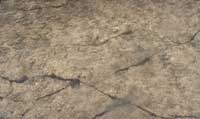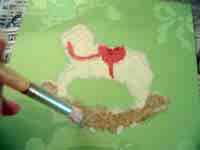What are Interior Decorating Paint Effects and Faux Finishes?
Decorative painting has been a very popular form of decoration that comes in and out of interior decorating fashion in waves.
With country themed interiors is seems to stay steady and the use of stencilling, color washing and marbling staying popular and working well as decorative detail.
The colorways used are also fashion orientated, I remember seeing loads of rag rolling in pastel colors when I first started out in interior design.
It was a really popular form of adding texture and color to walls and lets face it much easier and more fun for the DIY’er than hanging wallpaper.
There are many different types of decorative painting or paint effects; these can be grouped into two categories.
Decorative Paint Finishes
Decorative paint finishes are a form of changing the look and texture of a substrate by use of paint and often glazes or scumbles. I.e. dragging, combing, sponging.
Faux Finishes
Faux finishes are a form of imitating existing finishes onto our existing substrate. i.e. tortoise shelling, marbling, graining.
The following mediums are used for decorative painting techniques.
Scumble
Scumble is a translucent colored medium, which is applied over a dry substrate of a different color. While the scumble is wet, it is manipulated to reveal portions of the substrate color. It’s requirements are that it must remain open long enough to be worked. It should retain its shape when worked and not flow out and it must be clear coated to provide protection and durability.
Glaze
Glaze is a translucent coating, which is used to modify or enrich the work done previously with your scumble. It’s requirements are that it must remain open long enough for it to be worked. It should retain its shape when worked and not flow out and it must be clear coated to provide protection and durability.
So essentially the only difference between these two products is the order in which they are applied.
Different Types of Faux Finishes
Verdi Gris
Verdi Gris is the color that copper and bronze turn with age and unprotected exposure to the elements. It is a blue green shade and it is replicated in a paint effect.
Graining
Graining is the art of imitating natural timber graining. It is achieved by using a brush or comb to pull through the translucent glaze, which has been applied over a base coat. This creates a general grain, more ambitious imitations can be achieved, creating figured timber, knots and different sawn cut timbers, by drawing into the glaze.
Marbling
Marbling is the imitation of the natural product of marble often called faux marble. It is achieved by commencing with a base coat, painting on veins of various shades, dabbing and softening the painting, dry brushing to blur the effect, touching up and adding the required colored dabs, then applying varnish to seal it, when almost dry French chalk is sprinkled over it and polished to create the same sheen as marble.
There are two forms of marbling, the one mentioned above sometimes called marbelizing, which is an interpretation of marble or making an exact copy of the real thing, which is very time, and labor intensive.
Marbling
Tortoise Shelling
Tortise Shelling is the art of imitating tortoiseshell. It is achieved by working with wet varnish and adding the desired colours, these spread and are lightly brushed to create the desired markings. It is used for painting woodwork and occasionally walls.
Bambooing
Bambooing is the imitation of bamboo is achieved by painting turned or carved wood to copy the bamboo knots and grain, then decorating it. It was popular during the eighteenth century. It is often used to change the look of an old piece of furniture.
Stencilling – a form of Decorative Painting for Home Interior Design and Decorating
Stencilling
Stencilling is a form of decoration a way of adding color and pattern to surfaces. It means to produce a design by means of a stencil. A stencil is an impervious material perforated with a design or lettering through which a substance can be forced onto the surface behind. (Stencil plate)
A stencil must be strong and robust as the designs often entail a great deal of repetition. Paint is dabbed over the stencil with a stencil brush which provides a stippled effect and ensures that the design doesn’t run though at the edges because of too much paint.
Stencils can be classed into four main groups:
Feature Stencil
Border Stencil
Corner Stencil
Lettering Stencil
Some stencilling terms:
Positive Stencil – The paint is passed through the voids in the stencil plate to produce the design.
Negative Stencil – The paint is passed through the voids that surround the design.
Ties – These hold the stencils together.
Register Marks – These are marks that align the stencil for its repetition. They can be marks that are removable (i.e. pencil) or part of the design overlap.
Guide Lines – These are usually a chalk snap line on the surface so the height of the stencil can be aligned.
Positive stencil
Find More Knowledge on Color
Popular Color Schemes
Free Color Course
Color Articles
Color Information
Color Meanings
Color Schemes
Color Theory
Paint


